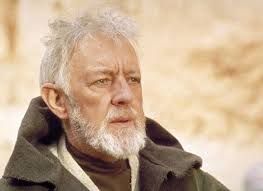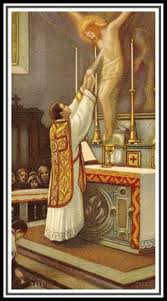 Dal sito catholic.com
Dal sito catholic.comL’insolita conversione di uno dei più famosi attori di cinema e teatro del XX secolo
di Rita Reichardt
traduzione di Gianmaria Spagnoletti
Nel 1957, Guinness vinse un Academy Award come migliore attore per la sua interpretazione ne Il ponte sul fiume Kwai (The Bridge over the River Kwai). Film successivi includono Guerre stellari (Star Wars), La piccola Dorrit (Little Dorrit), la serie TV La Talpa (Tinker, Tailor, Soldier, Spy) e Tutti gli uomini di Smiley (Smiley’s People). Nel 1959 fu fatto cavaliere dalla regina Elisabetta. Tuttavia, nella sua biografia Blessings in Disguise [Non tutto il male vien per nuocere] Guinness diede quasi più risalto alla sua conversione al cattolicesimo che al successo della sua carriera di attore.
La sua fu una conversione insolita.
Alec Guinness nacque a Londra nel 1914 da Agnes Cuffe, una ragazza madre che si prendeva cura di lui in maniera disordinata. Si rifiutò sempre di rivelare l’identità del padre, e Alec non scoprì mai perché il suo certificato di nascita riportasse il nome Guinness. Fino all’età di sei anni il bambino venne lasciato solo per ore e ore ogni giorno. Sua madre contrasse un breve matrimonio con un uomo brutale, odiato e temuto dal giovane Alec. L’unica tregua che il ragazzo potesse avere dalla miseria dell’indigenza e della trascuratezza arrivava quando veniva mandato a scuola. Da adolescente scoprì la magia del teatro.
All’età di sedici anni Guinness ricevette la Cresima anglicana, ma si dichiarò segretamente un ateo. “Certi avvenimenti o certe parole del Nuovo Testamento”, scrisse, “mi tiravano indietro, ogni tanto, verso qualcosa di molto vicino alla fede, e mantenni un interesse costante in materia di religione, benché fossi ignorante di qualunque teologia, ma per lo più cedevo al cinismo adolescenziale”.
Questo “interesse costante in materia di religione” portò il giovane Guinness a frequentare i riti presibiteriani per un certo periodo, ma l’attrazione fu di breve durata. Scrisse nella sua autobiografia che non gli era mai passato per la mente di varcare la soglia di una chiesa cattolica. Disse che la sua “tolleranza per i cattolici, a meno che non li si conoscesse di persona, era limitata a uno sguardo simpatetico, anche se condiscendente”.
Guinness lasciò la scuola a diciott’anni e lavorò come copywriter per un’agenzia pubblicitaria. Non pensava più molto alla religione, credendo che fosse solo “un mucchio d’immondizie, un maledetto complotto del Potere per tenere i lavoratori al loro posto”. Ebbe una infatuazione per il comunismo distribuendo libri marxisti/leninisti. Visitò incontri dei quaccheri, studio il buddismo e si interessò ai tarocchi.
La carriera di Guinness come copywriter fu un fallimento, così si rivolse al palcoscenico, realizzando un’attrazione che aveva avuto sin da bambino. Il successo non tardò ad arrivare. Recitava nell’Amleto all’Old Vic quando un prete anglicano andò a trovarlo in camerino. Il prete lamentò che in scena Guinness si benediceva nella maniera sbagliata. Questo incontro si rivelò un passo verso il cristianesimo.
In una terribile notte della seconda Guerra mondiale, mentre Londra veniva bombardata dalla Luftwaffe, Guinness cercò riparo nella canonica del Rev. Cyril Tomkinson. Era preoccupato per sua moglie e suo figlio, che erano in un cottage in affitto a Stratford-upon-Avon. Davanti a un bicchiere di vino di Bordeaux, il chierico anglicano diede a Guinness una copia dell’Introduzione alla vita devota di S. Francesco di Sales e gli consigliò di genuflettersi sempre davanti all’altare. Guinness non aveva idea di cosa si intendesse per “Presenza Reale” ma, con le bombe che esplodevano tutt’intorno, il momento non sembrava appropriato per una discussione.
Guinness tornò alla fede anglicana e spesso andava in bicicletta nell’oscurità delle mattine invernali per ricevere la comunione in una chiesa di campagna. La sua amicizia con Tomkinson aveva ridotto il suo anticlericalismo ma non il suo anticattolicesimo. Ci voleva Padre Brown perché quel processo avesse inizio.
Padre Brown è il monotono ma simpatico prete cattolico inventato da G. K. Chesterton. Una delle interpretazioni più memorabili di Guinness fu quella di questo prete umile e abile a risolvere delitti.
Il film veniva girato in uno sperduto villaggio francese. Una sera Guinness, ancora in costume di scena, stava tornando al suo alloggio. Un bambino, scambiandolo per un vero sacerdote, lo prese per mano e fiduciosamente accompagnò quel “prete”.
Quel fatto colpì Guinness. “Continuando a camminare”, disse, “Riflettei che una Chiesa che poteva ispirare una tale fiducia in un bambino rendendo i preti, anche sconosciuti, così facilmente avvicinabili, non poteva essere così “malvagia” o “inquietante” come spesso mi immaginavo. Cominciai a liberarmi dei miei vecchi, inveterati pregiudizi”.
Poco più tardi il figlio undicenne di Guinness, Matthew, si ammalò di poliomielite e fu paralizzato dalla vita in giù. Il futuro del ragazzo era incerto e, alla fine di ogni giorno di lavoro sul set, Guinness cominciò a frequentare una piccola chiesa cattolica posta sulla via di casa. Decise di fare un patto con Dio: se Dio avesse fatto guarire Matthew, Guinness non avrebbe ostacolato il figlio se avesse desiderato diventare cattolico.
Fortunatamente Matthew si riprese completamente, e Guinness e sua moglie lo iscrissero a un’accademia gesuita. A quindici anni Matthew annunciò che desiderava diventare cattolico. Guinness rispettò il suo patto con Dio: accettò la conversione di buon grado.
Ma Dio voleva molto di più. Guinness si mise a studiare il cattolicesimo. Ebbe lunghi colloqui con un prete cattolico. Fece un ritiro in un’abbazia trappista. Andò addirittura a Messa con Grace Kelly mentre lavorava a un film a Los Angeles. Le dottrine dell’indulgenza e dell’infallibilità papale lo rallentarono un po’, ma la sua descrizione di come finalmente entrò nella Chiesa è eloquente: “non c’era stato nessuno sconvolgimento emotivo, nessuna grande intuizione, certamente nessuna vera comprensione di materie teologiche; solo un senso di storia e di congruenza delle cose.”
Guinness fu accolto nella Chiesa cattolica dal vescovo di Portsmouth, e mentre era in Sri Lanka per girare Il ponte sul fiume Kwai sua moglie lo sorprese convertendosi anch’ella. Come nel caso di altri neoconvertiti, sentì periodi di pace profonda intervallati da piacere fisico. Narrò di aver corso una volta come un matto per visitare il Santissimo Sacramento in una chiesetta anonima. Riflettendo su quell’episodio scrisse: “Se la religione aveva un significato, questo era che l’uomo intero pregava, mente e corpo insieme … Ne ebbi una conferma quando scoprii che il buon, intelligente, e perfettamente sano Ronald Knox si era trovato a correre, in più di un’occasione, per visitare il Santissimo”.
Sir Alec Guinness morì nel 2000 a ottantaquattro anni, grato al Padre Brown di Chesterton, che lo aveva condotto per mano nella Chiesa, e alla guarigione di un bambino, che suggellò un patto con Dio.
* * *
Rita Reichardt è madre di cinque figli. Ha insegnato nelle scuole superiori,è stata catechista parrocchiale e attualmente conduce un programma su grandi libri cattolici. Scrive da La Grange, Illinois.
_________________________
How Father Brown Led Sir Alec Guinness to the Church
By Rita Reichardt
Sir Alec Guinness is considered one of the finest actors of the twentieth century, known for his ability to portray a wide range of characters. His portrayal of Hamlet on the London stage was widely acclaimed, and he won international success in his films. Who can forget his masterly depiction of Fagan in Oliver Twist or the wry humor in the comedies Kind Hearts and Coronets (in which he played eight roles), The Man in the White Suit, The Lavender Hill Mob, and The Captain’s Paradise?
In 1957, Guinness won an Academy Award for best actor for his performance in The Bridge over the River Kwai. Later films included Star Wars, Little Dorrit, and the television series Tinker, Tailor, Soldier, Spy, and Smiley’s People. In 1959 he was knighted by Queen Elizabeth. Yet in his autobiography, Blessings in Disguise, Guinness highlights his conversion to the Catholic Church almost more than the success of his acting career.
His was an unusual conversion.
Alec Guinness was born in London in 1914 to Agnes Cuffe, an unmarried woman who cared for him in a haphazard manner. She refused to divulge his father’s identity, and he never discovered why the name Guinness appeared on his birth certificate. By the time he was six, the child often was left alone for hours at a time. His mother entered a brief marriage to a brutal man who was hated and feared by young Alec. The boy’s only release from the misery of poverty and neglect came when he was sent away to school. As a teenager, he discovered the enchantment of the theater.
At the age of sixteen, Guinness was confirmed in the Anglican faith, but he secretly declared himself an atheist. “Certain incidents or sayings in the New Testament,” he wrote, “would pluck me back, from time to time, to something approaching belief, and I retained a constant interest in religious matters while being ignorant of any theology, but for the most part gave in to adolescent cynicism.”
This “constant interest in religious matters” led the young Guinness to attend Presbyterian services for a time, but the attraction did not last. He wrote in his autobiography that it had never even crossed his mind to step inside a Catholic church. He said his “tolerance for Catholics, unless one personally knew them, was limited to the sympathetic, although condescending” view.
Guinness left school at eighteen and went to work as a copywriter for an advertising agency. He no longer thought much about religion, believing it just “so much rubbish, a wicked scheme of the Establishment to keep the working man in his place.” He flirted with Communism by distributing Marxist/Leninist literature. He visited Quaker meetings, investigated Buddhism, and had an interest in tarot cards.
Guinness’s career as a copywriter was a failure, so he turned to the stage, realizing an attraction he had since childhood. Success came soon.
He was playing Hamlet at the Old Vic when an Anglican priest visited him in his dressing room. The priest complained that Guinness was blessing himself incorrectly in the play. This encounter turned out to be a step back toward Christianity.
On a terrible night during World War II, when London was under a Luftwaffe attack, Guinness sought shelter at Rev. Cyril Tomkinson’s vicarage. He was concerned about his wife and their young son, who were in a rented cottage in Stratford-upon-Avon. Over a glass of claret, the Anglican cleric gave Guinness a copy of St. Francis de Sales’s Introduction to the Devout Life and advised him always to genuflect before the altar. Guinness had no idea what was meant by the “Real Presence,” but with bombs exploding around them, it did not seem the appropriate time for discussion.
Guinness returned to the Anglican faith and often bicycled in the dark of winter mornings to receive communion in a country church. His friendship with Tomkinson had reduced his anti-clericalism but not his anti-Romanism. It took Father Brown to begin that process.
Father Brown is the drab and delightful Catholic priest invented by G. K. Chesterton. One of Guinness’s most memorable characterizations was of this humble, crime-solving cleric. The film was being shot in a remote French village. One evening Guinness, still in costume, was on his way back to his lodgings. A little boy, mistaking him for the real thing, grabbed his hand and trustingly accompanied the “priest.”
That incident affected Guinness. “Continuing my walk,” he said, “I reflected that a Church that could inspire such confidence in a child, making priests, even when unknown, so easily approachable, could not be as scheming or as creepy as so often made out. I began to shake off my long-taught, long-absorbed prejudices.”
Shortly thereafter, Guinness’s son Matthew, age eleven, was stricken with polio and paralyzed from the waist down. The future for the boy was doubtful, and at the end of each day’s work on the film, Guinness began dropping in at a little Catholic church on his route home. He decided to strike a bargain with God: If God would let Matthew recover, Guinness would not stand in the way if the boy wished to become Catholic.
Happily Matthew recovered completely, and Guinness and his wife enrolled him in a Jesuit academy. At the age of fifteen, Matthew announced that he wished to become Catholic. Guinness kept his end of the bargain with God: He readily agreed to the conversion.
But God wanted much more. Guinness began to study Catholicism. He had long talks with a Catholic priest. He made a retreat at a Trappist abbey. He even attended Mass with Grace Kelly while he was working on a film in Los Angeles. The doctrines of indulgences and infallibility slowed him for a time, but his description of finally entering the Church said it all: “There had been no emotional upheaval, no great insight, certainly no proper g.asp of theological issues; just a sense of history and the fittingness of things.”
Guinness was received into the Catholic Church by the bishop of Portsmouth, and while he was in Sri Lanka making The Bridge over the River Kwai, his wife surprised him by also converting. As is often the case with new converts, he felt periods of deep peace punctuated by physical delight. He recounts once running like a madman to visit the Blessed Sacrament in a little nondescript church. Reflecting on that episode, he wrote, “If religion meant anything at all it meant that the whole man worshiped, mind and body alike. There was some reassurance when I discovered that the good, brilliant, acutely sane Ronald Knox had found himself running, on several occasions, to visit the Blessed Sacrament.”
Sir Alec Guinness died in 2000 at the age of eighty-four, grateful to Chesterton’s Father Brown, who led him by the hand into the Church, and to a young boy’s recovery, which sealed a bargain with God.




